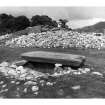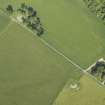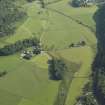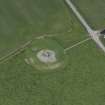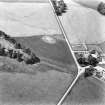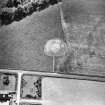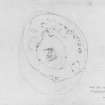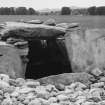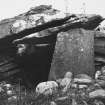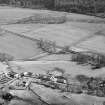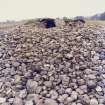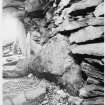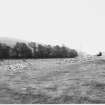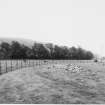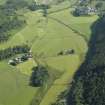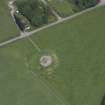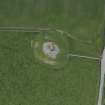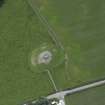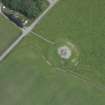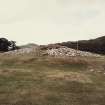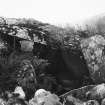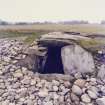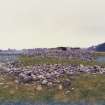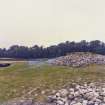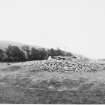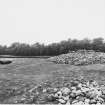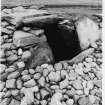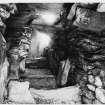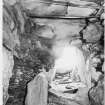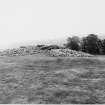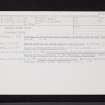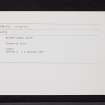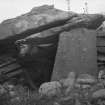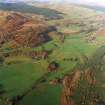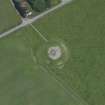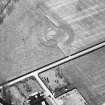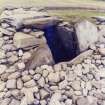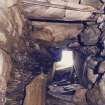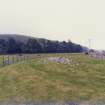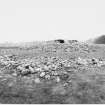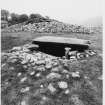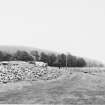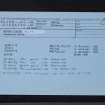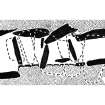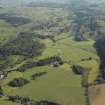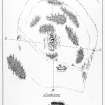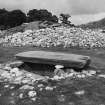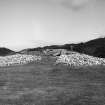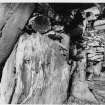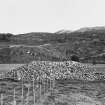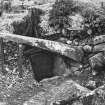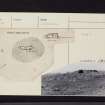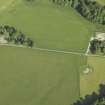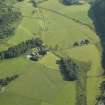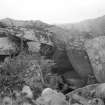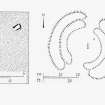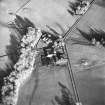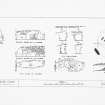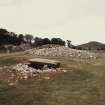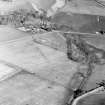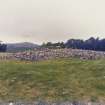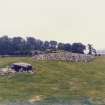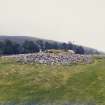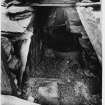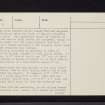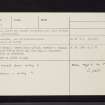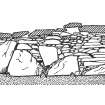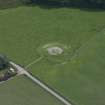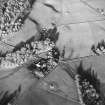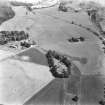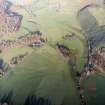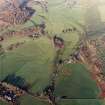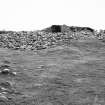Following the launch of trove.scot in February 2025 we are now planning the retiral of some of our webservices. Canmore will be switched off on 24th June 2025. Information about the closure can be found on the HES website: Retiral of HES web services | Historic Environment Scotland
Nether Largie South
Chambered Cairn (Neolithic)
Site Name Nether Largie South
Classification Chambered Cairn (Neolithic)
Canmore ID 39460
Site Number NR89NW 2
NGR NR 82860 97920
Datum OSGB36 - NGR
Permalink http://canmore.org.uk/site/39460
First 100 images shown. See the Collections panel (below) for a link to all digital images.
- Council Argyll And Bute
- Parish Kilmartin
- Former Region Strathclyde
- Former District Argyll And Bute
- Former County Argyll
NR89NW 2 82860 97920.
(NR 8287 9794) Cairn (NR)
OS 6" map (1924)
The New Statistical Account (NSA) notes 'urns' found in cairns in the Kilmartin Valley.
NSA 1845.
This Clyde-type chambered round cairn is near the centre of, and the earliest monument in, a linear cemetery stretching almost 3 miles. It is stated (W Greenwell 1865) to have had a diameter 134', but the greater part of it had been removed by 1864. Today, most of the remaining cairn material is heaped around the chamber, reaching the level of the capstones. Around the S half of the site grass-covered cairn-stones spread well beyond this heap, and there is a fairly well-defined edge c. 52' from the chamber. This edge is less evident on the N, and on the W, all the outer cairn material has been removed. The present edge round the E side is probably roughly that of the ancient cairn, for it gives a diameter of 120' if the cairn is assumed to be round with the chamber set centrally, as the present appearance seems to indicate. On the S and E the area between the edge and the heaped cairn material is now mainly flat and suggests (J G Callander 1929) a platform on which the cairn, of smaller circumference, was built. This suggestion cannot be verified as the site has been so badly robbed and disturbed, though it seems more likely that the large circular 'platform' is the base of a robbed extension of the original cairn, made to take the secondary cist burials.
The chamber excavated by Greenwell in 1864, is entered at its NE end, between two tall portal stones. It is 20' long, by 6' wide at the N, and 3'7" wide at the S end, constructed of blocks of schist set on their ends or sides, supplemented by a considerable amount of dry walling.
Two short cists had been exposed in the cairn before the excavation. One is still visible towards the S side, c. 32' behind the chamber. It measures 3'8" x 2'8" x 3' deep, with a cover stone 7'6" x 3'6". This cist was empty. Another, smaller cist, 5'4" x 3'1" x 4' deep, was found towards the N side, 24' from the centre of the cairn.
The finds from the excavation, in the British Museum, include Neolithic bowl, beaker, food vessel and cinerary urn sherds, barbed and tanged arrowheads and flint flakes.
A S Henshall 1972, visited 1961; J H Craw 1930; J N G Ritchie 1973; M Campbell and M Sandeman 1964
As described.
Resurveyed at 1:2500.
Visited by OS (AA) 25 April 1973
Nether Largie - South Cairn (DoE nameplate) measuring 31.0m N-S by 29.0m and 2.1m high is otherwise generally as described.
Surveyed at 1/2500.
Visited by OS (TRG) 15 February 1977
Field Visit (June 1981)
This chambered cairn is situated at the centre of a linear setting of cairns at Kilmartin (see RCAHMS 1988 Nos. 62, 67-8) a little to the S of Kilmartin Primary School and Nether Largie (Campbell and Sandeman 1964; Henshall 1972). In 1864 Greenwell reported that the cairn had a diameter of about 40 m and that it had already been severely robbed to provide material for walls and drains; it is now a grass-covered mass of stones measuring about 34m by 27m, and it is likely that in its final form it was a circular mound between 34m and 40m in diameter and over 4m in height. In 1864 Greenwell excavated the chamber and examined two secondary cists, and the following account is based in part on his published report (Greenwell 1865).
The chamber, which belongs to the Clyde type, is at the centre of the cairn and is aligned NE and SW with the entrance at the NE end. Built partly of massive orthostats and partly of drystone walling, the chamber comprises four compartments separated by upright slabs and measures 6.1m in length by 1.9m in breadth at the NE end and 1m in breadth at the SW end; Greenwell records that the septal slabs were about 0.8m in height, and, as they now protrude only a little above the gravel floor, the original floor level is clearly much lower.
The first compartment is entered between two tall portal stones some 0.9m apart, that on the NW being 1.85m high and that on the SE being visible to a height of 1.4m with at least another 0.4m below present ground level; the sill-stone just protrudes, and the entrance itself is partly blocked by two flat slabs and drystone walling, which may form part of the original sealing of the tomb. The first compartment measures 1.9m by 1.2 m with the side-slabs reaching to the height of the capstones of the chamber as shown on the section; only the back-slab is as tall, and the capstones are elsewhere supported on drystone walling on top of the orthostats at a height of about 1.7m above the present floor level. The slabs of the SE side all overlap one another, but on the NW side, apart from a basal slab in the rear compartment and the massive slab of the first, the walling is largely of drystone construction. A supplementary slab helps to support the SE side behind the second and third orthostats; it stands to a height of about 1.37m above floor level, but it is likely that it was originally masked by drystone walling. It is possible that the stone that is embedded in the floor of the third compartment is a fragment of a broken lintel. At the end of the chamber a slab about 0.3 m in thickness is wedged into position against the back-slab at a height of about 0.3m; Greenwell described this stone as being ?2 feet 7 inches from the bottom? of the chamber (about 0.8m) and resting on ?two upright stones, one at each end? (Greenwell 1865). Henshall comments on the unusual relationship of the slabs at the end of the chamber with the back-slab which necessitated this bracing stone (Henshall 1972).
Greenwell's excavation provided detailed information about the deposits recovered from the chamber. In the rear compartment a small cist composed of four upright slabs, a capstone and a basal slab was found in the SE corner; the cist had been rifled and the cover was lying nearby, but Greenwell considered that sherds of Beaker pottery and unburnt bones found scattered around probably represented the original interment. Several layers of filling were encountered beneath the cist. Just to the N of the cist and on a level with the basal slab, a further slab covered a cremation deposit. A carefully laid 'pavement' of small pebbles about 230 mm wide and with flat stones at each end ran down the centre of the compartment; beneath it there was a layer of dark earthy matter with cremated bones, the bones 'becoming more thickly spread in the space between the pavement and the sides of the chamber'. This layer also contained three perfect and two broken barbed-and-tanged arrowheads, several other flint implements, 'great numbers of broken quartz pebbles' and a bovine tooth. The black layer covered a second pebble pavement on the floor of the compartment. Several vessels were recovered: a fragment of a Beaker (several other sherds of which were found in the third compartment) was discovered on the black layer to the W of the cist; a round-based Neolithic vessel was found to the N of the cist and close to the side of the chamber, 'amongst the undisturbed layer of dark earthy matter'.
The third compartment also contained a deposit of dark earthy matter with cremated bones resting on a pebble pavement; on top of this layer were sherds of three Beakers including a fragment of the same vessel that was found in the end compartment. The deposits in the third compartment were not in well-preserved layers, but human and bovine bones were found as well as 'a few fragments of a rudely made, dark coloured urn, without any pattern on it'.
The outer compartment, which also contained unburnt bones and pottery in an upper deposit, apparently in some disarray, was distinguished by side-walls built against the main orthostats, with a space of some 0.66m as a central passage between the two blocks of masonry; some trace of this may still be seen in the floor of the chamber. Two flints were discovered, but there was no trace of any burial-deposit.
Two secondary cists were also found within the cairn material; one, no longer visible, was about 7m to the N of the centre of the cairn and measured 1.6m in length, 0.94m in breadth, and 1.2m in depth. Although the cover slab remained in position, no traces of burial were discovered, but fragments of a Food Vessel were found. The second cist may still be seen 8.5m to the SSW of the chamber beneath its substantial capstone; built of four massive slabs, it measures 1.15m by 0.8m and 0.83m in depth and was found to be empty. It is possible that the cairn was enlarged to incorporate these later burials.
All the surviving finds are in the British Museum, London.
RCAHMS 1988, visited June 1981.
Measured Survey (15 June 1981)
RCAHMS surveyed Nether Largie South chambered cairn on 15 June 1981 with plane-table and alidade producing a plan at a scale of 1:100. The plan of the cairn was redrawn in ink and published at a scale of 1:250 (RCAHMS 1988a, 48).
Publication Account (1985)
This cairn was probably the oldest of the series of burial sites that fonn the linear cemetery at Kilmartin; it contained a well-preserved chamber of Clyde type, the customary tomb-architecture of the neolithic inhabitants of Argyll, as well as two individual cists, only one of which is still visible. The chamber is now at the centre of a large cairn measuring about 40m in overall diameter, but it is likely that the final shape of the cairn owes more to its reconstruction when the bronze-age cists were added than to the original intentions of the neolithic builders. The cairn was most probably trapezoidal with the straight sides now masked by the addition of further stones. The chamber is oblong on plan, measuring 6m in length and up to 1.2m in width, and is divided by transverse slabs into four compartments. The massive slabs of the eastern side of the chamber, supplemented by drystone walling, appear to be original; the western side is at least in part reconstructed. The slabs of the roof may also have been replaced. There are two transverse slabs at the entrance as well as a pair of blocking stones. Entry is now made by going across the cairn and then dropping down over these blocking slabs; but when the tomb was in use there would probably have been no cairn material in front of the tomb and there may have been an impressive facade or forecourt fonned by upright slabs leading straight into the chamber.
It is known from excavations carried out by Canon Greenwell in 1864 that the floor level of the chamber was about 0.6m below the present layer of gravel, and that the transverse slabs would thus have been a much more dominant feature of the interior of the tomb.
The innennost pair of compartments was found to be paved with small pebbles, which were covered with an earthy layer containing cremated bone, a round-based neolithic vessel and quartz chips; in the inner compartment there was a small cist above the earthy layer. The cist itself was empty, but the excavator found parts of several Beakers, and inhumation burials were found nearby. In the other compartments there was only stone and rubble.
Of the two cists, both of which had been found before Greenwell's excavation, only that to the south-west of the chamber can still be seen, but nothing is known about its original contents. On the north side of the chamber there was a second cist which contained a fine Food Vessel, but there appears to have been no trace of any burial remains. It is suggested that the shape of the cairn was changed as a result of the addition of these two cist burials over a thousand years after the building of the chamber.
The finds from the excavation are in the British Museum, London.
Information from ‘Exploring Scotland’s Heritage: Argyll and the Western Isles’, (1985).










































































































